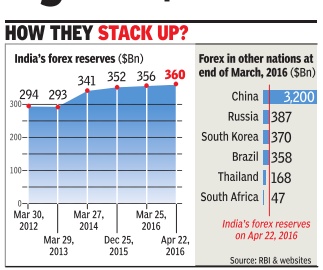Foreign exchange reserves, expenditure: India
This is a collection of articles archived for the excellence of their content. |
Contents |
Increases and decreases over the years
2012-16: India's foreign exchange reserves

See graphic, 'India’s foreign exchange reserves, 2012-16, and comparison with Brazil, Russia, China, South Africa, South Korea and Thailand'
2016, Aug: $365.5bn: the then record
Aug 06 2016 : PTI Forex kitty at all-time high of $365.5bn
Country's foreign exchange reserves rose by $2.8 billion to reach a life-time high of $365.5 billion in the week to July 29, helped by rise in foreign currency assets, the Reserve Bank said on Firday.
In the previous week, the reserves had dropped by $664 million to $362.7 billion.
Foreign currency assets (FCAs), a major component of the overall reserves, rose $2.8 billion to $341.04 billion in the reporting week, RBI data showed. FCAs, expressed in dollar terms, include the effect of appreciationdepreciation of non-US currencies such as euro, pound and yen held in the reserves.
Gold reserves remained unchanged at $20.6 billion.
The country's special drawing rights with International Monetary Fund increased by $8.5 million to $1.5 billion while the reserve position rose by $13.6 million to $2.4 billion, RBI said.
2017: $400bn mark touched for first time
Forex kitty hits $400bn for first time, Sep 16 2017: The Times of India

India's forex reserves crossed the $400-billion mark for the first time on Sep 15, 2017. The latest $100 billion has been added to the reserves in three and a half years after they crossed the $300-billion level on April 2014. At current level, the reserves are enough to fund more than a year of imports. In nominal terms, foreign exchange reserves have increased by $6.6 billion during the first quarter. The reserves have risen by $30 billion since Urjit Patel took charge as RBI governor in September 2016.
An increase in these reserves provides the RBI with ammunition to tackle volatility in the forex market. The forex reserves are built up by the central bank by purcha sing dollars from banks. According to RBI data, the reserves -which comprise foreign currency assets (FCAs), gold and special drawing rights with the International Monetary Fund -stood at $400.7 as on September 8.
The highest contribution to the reserves has been from foreign portfolio investors.During the April-September quarter, foreign direct investment surged by $7.2 billion in the reporting period from $3.9 billion in the same period last year. Foreign institutional investment flows increased by $11.9 billion in the first quarter from $1.2 billion in the same period last year.
The central bank's buildup of reserves comes ahead of the US Federal Reserve exiting its stimulus -a move which is expected to result in funds moving back into US dollar assets. Accretion to reserves are expected to slow down with a widening of the current account deficit (CAD) and rising crude oil prices. Foreign institutional investors have pulled out $810 million from the equity market in September on the back of $1.7 billion in August.